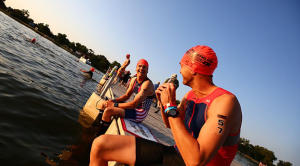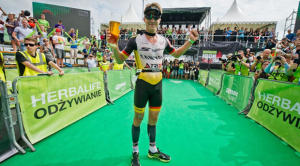
1 of 1 photo
<
>
In the intervening years, Jones obtained a PhD in marine biology at the Scripps Institution of Oceanography at UC San Diego and transformed himself from a swimmer into a triathlete. After five years, he placed second at the 2014 USA Triathlon Olympic distance Collegiate Nationals and was second at the 2015 USA Triathlon Collegiate Nationals in the draft-legal sprint distance.
Last year he put triathlon training and racing on hold to complete his PhD thesis, which he says involved a survey “reconstructing a 2,000 year fish population off the coast of California. We covered from zero A.D. to the present day.” The most common were mid-water fishes which vertically migrate from 500 to 1,000 meters depth. “They come up at night and feed. The most interesting is the Lanternfish, also known as Symbolophorus barnardi. They have little bioluminescent organs that allow them to blend in so when a predator looks at them from below their bioluminescent organs make them blend into the surface. It is their form of camouflage.”
Once his PhD was finished, Jones returned to training a few weeks before USA Triathlon age group nationals and hoped for the best.
Given his competitive swim background, Jones was happy that the water temperature was 80.6 degrees – ruling out neoprene wetsuits. “I opted to do the race in an XTERRA speed suit,” he explained. “Not a lot of people do. It’s a skin suit and it is very fast in the water. People use it in Kona over top of their race kits. I thought if it was fastest in the water, why not wear it the whole time?”
Taking off in the middle of the many start waves, Jones opened with a second-best 19:55 swim split which was 29 seconds ahead of his closest overall competitor, Ian Hoover-Grinde of Cedar Rapids, Iowa, who was competing in the 17-19 category. Jones’ day almost ended at the swim exit. “I slipped coming out of the swim on the bleacher run up stairs,” he said. “My leg went down between two of them. Put a pretty big hole in my leg. It turned out OK. Not life threatening. But my leg was all bloody.”
Whereupon Jones really got going, posting a 57:06 bike split (26.1 mph) which was 43 seconds better than Hoover-Grinde and 37 seconds better than his nearest 30-34 competitor Derek Jakoboski, who was well behind after a 22:26 swim. Still, the crowded bike course was not a breeze, turning the 40 kilometers into one long slalom course. “There was a lot of dodging. Honestly there was more dodging on the run.”
Jones closed with a 36:16 10k run which brought him to the finish in 1:56:19 with a 1:32 margin of victory over Hoover-Grinde and 2:05 ahead of his closest 30-34 competitor, Jakoboski.
After the race, Jones was treated at the medical tent where doctors wrapped up his leg. Soon, he will return to the San Diego area for his work at the Port of San Diego – and his very efficient training regimen.
“I dub my workout schedule ‘The 30 Minute Workout.’ It’s for those who work full time and don’t have much flexibility. So I just cut out the in between time. It is not just 30 minutes total - it’s three 30 minute segments. Before work I do a 30 minute run, mainly intervals. Then I do a 30 minute swim - all intervals, 100s on 1:20. Then I take a 30 minute bike ride from my home in La Jolla to my office just north of the San Diego International Airport. After work, I simply commute back.”
Last year he put triathlon training and racing on hold to complete his PhD thesis, which he says involved a survey “reconstructing a 2,000 year fish population off the coast of California. We covered from zero A.D. to the present day.” The most common were mid-water fishes which vertically migrate from 500 to 1,000 meters depth. “They come up at night and feed. The most interesting is the Lanternfish, also known as Symbolophorus barnardi. They have little bioluminescent organs that allow them to blend in so when a predator looks at them from below their bioluminescent organs make them blend into the surface. It is their form of camouflage.”
Once his PhD was finished, Jones returned to training a few weeks before USA Triathlon age group nationals and hoped for the best.
Given his competitive swim background, Jones was happy that the water temperature was 80.6 degrees – ruling out neoprene wetsuits. “I opted to do the race in an XTERRA speed suit,” he explained. “Not a lot of people do. It’s a skin suit and it is very fast in the water. People use it in Kona over top of their race kits. I thought if it was fastest in the water, why not wear it the whole time?”
Taking off in the middle of the many start waves, Jones opened with a second-best 19:55 swim split which was 29 seconds ahead of his closest overall competitor, Ian Hoover-Grinde of Cedar Rapids, Iowa, who was competing in the 17-19 category. Jones’ day almost ended at the swim exit. “I slipped coming out of the swim on the bleacher run up stairs,” he said. “My leg went down between two of them. Put a pretty big hole in my leg. It turned out OK. Not life threatening. But my leg was all bloody.”
Whereupon Jones really got going, posting a 57:06 bike split (26.1 mph) which was 43 seconds better than Hoover-Grinde and 37 seconds better than his nearest 30-34 competitor Derek Jakoboski, who was well behind after a 22:26 swim. Still, the crowded bike course was not a breeze, turning the 40 kilometers into one long slalom course. “There was a lot of dodging. Honestly there was more dodging on the run.”
Jones closed with a 36:16 10k run which brought him to the finish in 1:56:19 with a 1:32 margin of victory over Hoover-Grinde and 2:05 ahead of his closest 30-34 competitor, Jakoboski.
After the race, Jones was treated at the medical tent where doctors wrapped up his leg. Soon, he will return to the San Diego area for his work at the Port of San Diego – and his very efficient training regimen.
“I dub my workout schedule ‘The 30 Minute Workout.’ It’s for those who work full time and don’t have much flexibility. So I just cut out the in between time. It is not just 30 minutes total - it’s three 30 minute segments. Before work I do a 30 minute run, mainly intervals. Then I do a 30 minute swim - all intervals, 100s on 1:20. Then I take a 30 minute bike ride from my home in La Jolla to my office just north of the San Diego International Airport. After work, I simply commute back.”
PREV
NEXT
1 of 1 photo

>
<



